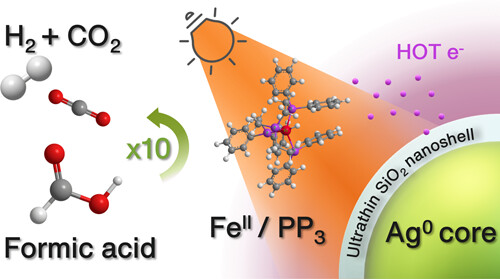Abstract
Plasmonic nanoparticles (PNPs) constitute a significant category of photoresponsive materials whose exploitation in photoboosted catalysis is a forward-looking strategy. Here, it is demonstrated that photoexcited core–shell Ag0@SiO2 PNPs can dramatically enhance formic acid dehydrogenation (FADH), catalyzed by the molecular catalyst [Fe(BF4)2·6H2O/P(CH2CH2PPh2)3, PP3]. In the presence of photoexcited Ag0@SiO2 PNPs, the optimized catalytic system [(Fe/PP3)/HCOOH/Ag0@SiO2/hv] achieves an almost 10-fold increase of the H2-gas-production rate vs [(Fe/PP3)/HCOOH] (173 vs 17 mL H2 min–1, using 12.5 μmol of catalyst), while the turnover numbers (TONs) are boosted by ∼400% (35,643 vs 9615) and the turnover frequencies (TOFs) by ∼600% (17,821 h–1vs 2885 h–1). Selective excitation at wavelengths (λex) spanning the photoresponse profile of Ag0@SiO2 NPs demonstrates that the FADH enhancement is maximal at λex = 405 nm, which is at the peak of the photoplasmonic response of Ag0@SiO2 NPs. Monitoring of the solution potential (Eh) under catalytic conditions reveals that the photoexcitation of Ag0@SiO2 PNPs injects hot electrons, as reducing agents, into the reaction solution. Varying the SiO2-shell thickness of Ag0@SiO2 PNPs in the range of 3–5 nm allowed control of the hot-electron injection rates and the ensuing FADH rates. The present results are discussed in the context of the catalytic cycle of the [(Fe/PP3)/HCOOH] system, where plasmonically generated hot electrons boost H2 production via FADH by molecular catalysts, in distinction to the thermoplasmonic effects that seem to play a secondary role. The present H2-production rate data demonstrate the possibility to approach industrial-scale H2-production rates via FADH, using low-cost Fe-based catalysts and no sacrificial cocatalysts. We consider that the phenomenon exemplified herein for a standard molecular-catalysis system, such as [(Fe/PP3)/HCOOH], can be valid for many other pertinent molecular FADH catalysts.
